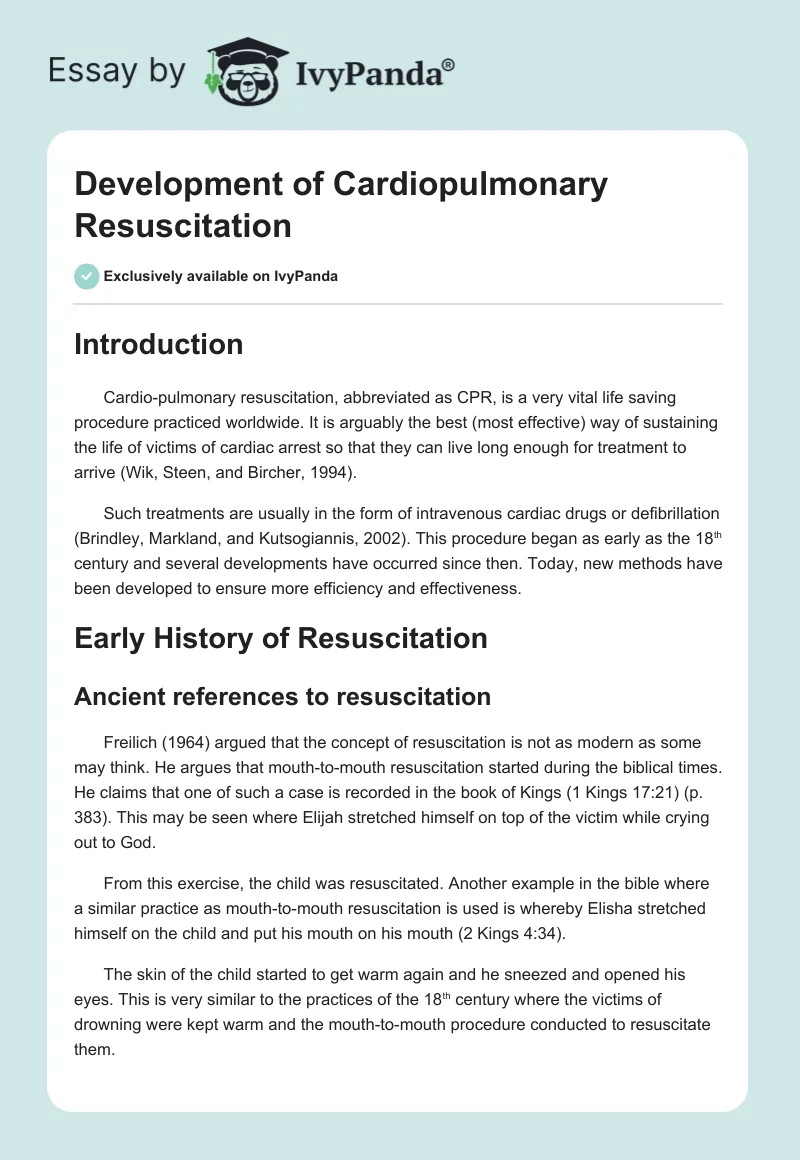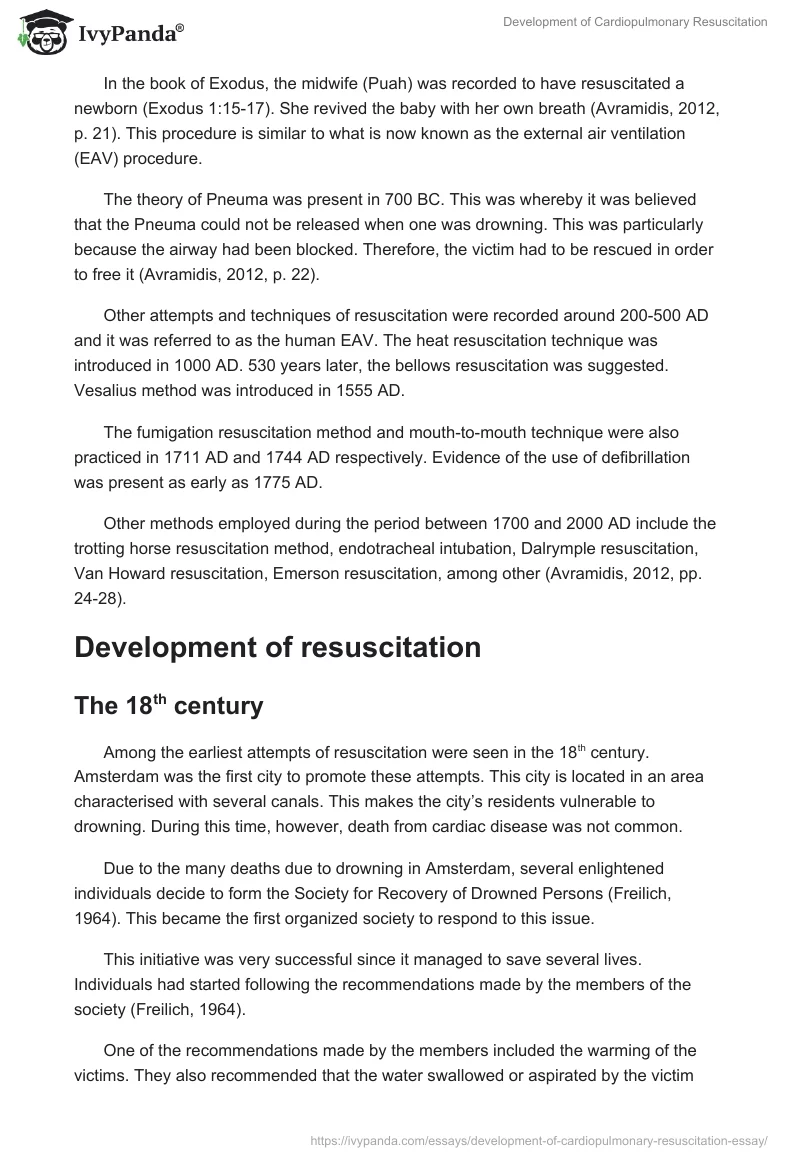Introduction
Cardio-pulmonary resuscitation, abbreviated as CPR, is a very vital life saving procedure practiced worldwide. It is arguably the best (most effective) way of sustaining the life of victims of cardiac arrest so that they can live long enough for treatment to arrive (Wik, Steen, and Bircher, 1994).
Such treatments are usually in the form of intravenous cardiac drugs or defibrillation (Brindley, Markland, and Kutsogiannis, 2002). This procedure began as early as the 18th century and several developments have occurred since then. Today, new methods have been developed to ensure more efficiency and effectiveness.
Early History of Resuscitation
Ancient references to resuscitation
Freilich (1964) argued that the concept of resuscitation is not as modern as some may think. He argues that mouth-to-mouth resuscitation started during the biblical times. He claims that one of such a case is recorded in the book of Kings (1 Kings 17:21) (p. 383). This may be seen where Elijah stretched himself on top of the victim while crying out to God.
From this exercise, the child was resuscitated. Another example in the bible where a similar practice as mouth-to-mouth resuscitation is used is whereby Elisha stretched himself on the child and put his mouth on his mouth (2 Kings 4:34).
The skin of the child started to get warm again and he sneezed and opened his eyes. This is very similar to the practices of the 18th century where the victims of drowning were kept warm and the mouth-to-mouth procedure conducted to resuscitate them.
In the book of Exodus, the midwife (Puah) was recorded to have resuscitated a newborn (Exodus 1:15-17). She revived the baby with her own breath (Avramidis, 2012, p. 21). This procedure is similar to what is now known as the external air ventilation (EAV) procedure.
The theory of Pneuma was present in 700 BC. This was whereby it was believed that the Pneuma could not be released when one was drowning. This was particularly because the airway had been blocked. Therefore, the victim had to be rescued in order to free it (Avramidis, 2012, p. 22).
Other attempts and techniques of resuscitation were recorded around 200-500 AD and it was referred to as the human EAV. The heat resuscitation technique was introduced in 1000 AD. 530 years later, the bellows resuscitation was suggested. Vesalius method was introduced in 1555 AD.
The fumigation resuscitation method and mouth-to-mouth technique were also practiced in 1711 AD and 1744 AD respectively. Evidence of the use of defibrillation was present as early as 1775 AD.
Other methods employed during the period between 1700 and 2000 AD include the trotting horse resuscitation method, endotracheal intubation, Dalrymple resuscitation, Van Howard resuscitation, Emerson resuscitation, among other (Avramidis, 2012, pp. 24-28).
Development of resuscitation
The 18th century
Among the earliest attempts of resuscitation were seen in the 18th century. Amsterdam was the first city to promote these attempts. This city is located in an area characterised with several canals. This makes the city’s residents vulnerable to drowning. During this time, however, death from cardiac disease was not common.
Due to the many deaths due to drowning in Amsterdam, several enlightened individuals decide to form the Society for Recovery of Drowned Persons (Freilich, 1964). This became the first organized society to respond to this issue.
This initiative was very successful since it managed to save several lives. Individuals had started following the recommendations made by the members of the society (Freilich, 1964).
One of the recommendations made by the members included the warming of the victims. They also recommended that the water swallowed or aspirated by the victim should be removed. This was to be achieved by placing the feet at a position higher than the head. Application of pressure to the abdomen was also to be done manually.
The mouth-to-mouth technique was also introduced during this period. This was done by respiring into the victim’s mouth or nostrils. This could be done after a handkerchief or cloth was placed over the area of respiration.
This was in order to make the operation less indelicate. The techniques described above are still in use today. Another recommendation made during this period included tickling the victim’s throat.
Tobacco smoke was also used to stimulate the victim. This was done through oral or rectal fumigation. Bloodletting was also used. Some of these techniques are no longer in use since they are not in line with modern science. Therefore, they have been replaced with modern techniques (Boyle et al., 2002).
The initiatives of this first society brought hope since it proved that resuscitation was possible. Soon, various other rescue societies were developed within the European countries. The popularity of these procedures was even seen in Germany. In this country, an ordinance was passed.
This led to the reading of notices in churches in order to provide information about the proper ways of attending to drowning or strangled victims.
A similar rescue society was initiated in London and it was referred to as the Royal Humane Society. These societies have greatly shaped the current practices in health care, which includes the founding of emergency medical services (Cary, 1918).
The 20th century
During this period, more developments were noted in Japan. In the early 1990s, Japan introduced such practices in books such as the Judo and the Jujutsu. They were referred to as Kutasu or Kappo. For many years, several more techniques were proposed by various individuals.
One of the techniques that were suggested was the back pressure-arm lift technique. This technique was successful in several occasions when it came to the saving of drowning victims. This was so because it helped to initiate respiration. The immediate danger faced by drowning victims is the inability to breath.
The victim might survive underwater for between five to ten minutes since the heart would still be beating. However, this technique was not applicable for victims of cardiac arrest. Circuldesation of the blood was required for such victims and yet the technique did nothing to facilitate circulation (Casner, Anderson, and Isaacs, 2005).
Most recent developments and rationale
Some of the new developments in Cardio-pulmonary resuscitation include the active compression-depression resuscitation and abdominal compression (Milander et al., 1995). These are done in between chest compressions. The active compression-decompression resuscitation has been reported to improve circulation from the heart.
Chest compression has also been done using a pneumatic vest. The interposed abdominal counter-pulsation is another proposed but not fully implemented procedure. This procedure requires two or more individuals.
One of the individuals compresses the chest with the other compresses the victim’s abdomen. This procedure was proposed in order to improve pressure, which is required for improved circulation of blood.
The pneumatic vest is also a recent development in cardiopulmonary resuscitation. It covers the chest area of the victim and compresses it. It is meant to increase the pressure within the chest region as compression is done externally. This vest has been used to save many lives over the years.
Another recent development is the automated external defibrillator (ADE) (Kramer-Johansen, Myklebust, and Wik, 2006). The victims are attached to this machine. This is whereby their heart rhythm is checked. The machine has the ability to pass electric current (shock) in the victim’s body.
The two pads from the equipment are placed on different positions of the victim’s chest in order to shock him or her (Berg et al., 1994). This method is also effective for cardiac arrest victims. Some of these victims have heart rhythms referred to as ventricular fibrillation.
The only way to bring normalcy to such a heartbeat is through electrocution. Due to its efficiency and success in saving lives, it has become part of the CPR chain of survival (Grace and Chadbourn, 1969).
Possible future developments
One of the future developments in cardiopulmonary resuscitation is the use of hypothermia. This technology dates back to Hippocrates (Cary, 1918). This procedure would make it possible for procedures to be done on a living heart after it has been stopped. This is also done on a blood free environment.
In the past, some scientists have been able to perform surgeries on patients without circulation for over an hour. Despite the efficiency of this procedure, it was stopped due to some of the limitations such as the possibility of infection of the heart. There was also limited and inconsistent research on the procedure.
Future developments should also find a way of improving neurological recovery after resuscitation. Several deaths have been associated with brain damage (neurologic injury) due to insufficient cerebral oxygen flow during the procedure (Baubin et al., 1999).
Conclusion
Cardio-pulmonary resuscitation has been described as a lifesaver when it comes to victims of cardiac arrest (Perkins et al., 2004). This procedure was practiced (though in other forms) several centuries ago. Some of the practices, such as the mouth-to-mouth technique are still in use today.
However, some have been done away with as newer technologies arrive. The future of Cardio-pulmonary resuscitation is still big as greater innovations are yet to be introduced. With this, more lives will be saved as unnecessary deaths are avoided.
References
Avramidis, S 2012, ‘Facts, legends and myths on the evolution of resuscitation’, International Aquatic History Symposium and Film Festival, pp. 21-31.
Baubin, M, Rabl, W, Pfieffer, K, Benzer, A & Gilly, H 1999, ‘Chest injuries after active compression-decompression cardiopulmonary resuscitation (ACD-CPR) in cadavers’, Resuscitation, vol. 43, no. 1, pp. 9–15.
Berg, R, Sanders, A, Milander, M, Tellez, D, Liu, P & Beyda, D 1994, ‘Efficacy of audio-prompted rate guidance in improving resuscitator performance of cardiopulmonary resuscitation on children’, Acad Emerg Med, vol. 1, no. 1, pp.35–40.
Boyle, A, Wilson, A, Connelly, K, McGuigan, L, Wilson, J & Whitbourn, R 2002, ‘CPREzy: an evaluation during simulated cardiac arrest on a hospital bed’, Resuscitation, vol. 54, no. 1, pp. 32-43.
Brindley, P, Markland, D & Kutsogiannis, D 2002, ‘Predictors of survival following in-hospital adult cardiopulmonary resuscitation’, Canadian Medical Association Journal, vol. 174, no. 4, pp. 343–8.
Cary, R 1918, ‘A brief history of the methods of resuscitation of the apparently drowned’, Journal of Johns Hopkins Hospital Bulletin, vol. 270, no. 1, pp. 243-251.
Casner, M, Anderson, D & Isaacs, S 2005, ‘The impact of a new CPR assist device on the rate of return of spontaneous circulation in out-of-hospital cardiac arrest’, Prehospital Emergency Care, vol. 9, no. 1, pp. 61–7.
Freilich, H 1964, ‘Ancient Accounts of mouth-to-mouth resuscitation’, Journal of the American Medical Association, 189(5), 383.
Grace, W & Chadbourn, J 1969, ‘A mobile coronary care unit’, Disease of the Chest, vol. 55, no. 1, pp. 452-455.
Kramer-Johansen, J, Myklebust, H & Wik, L 2006, ‘Quality of out-of-hospital cardiopulmonary resuscitation with real time automated feedback: a prospective interventional study’, Resuscitation, vol. 71, no. 3, 283–92.
Milander, M, Hiscok, P, Sanders, A, Kern K, Berg, R & Ewy, G 1995 ‘Chest compression and ventilation rates during cardiopulmonary resuscitation: the effects of audible tone guidance’, Acad Emerg Med, vol. 2, no. 8, pp. 708–13.
Perkins, G, Augre, C, Rogers, H, Allan, M & Thickett, D 2004 ‘CPREzy: an evaluation during simulated cardiac arrest on a hospital bed’, Resuscitation, vol. 64, no. 1, pp. 103–8.
Wik, L, Steen, P & Bircher, N 1994, ‘Quality of bystander cardiopulmonary resuscitation influence outcome after prehospital cardiac arrest’, Resuscitation, vol. 28, no. 4, pp. 195–203.


